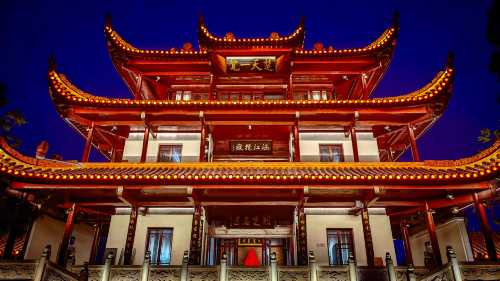Popular Trip Moments
Treasure Hotel Found in Changsha! Detail-Oriented Guests Will Scream with Joy! | If you're looking for a place to rest your body and soul while touching the essence of Changsha, I recommend Yijian·6500 in Chaozong Ancient Street. Its name | Changsha Tongguan Kiln Site, Hunan | Must-Stay Pool Hotel! Sky-High Infinity Pool Overlooking IFS, Nightlife of Jiefangxi Right Below | The Living Canvas: Art, Water, and Community on Changsha's Orange Island | The Whispering Walls: Yuelu Academy's Millennia of Wisdom | Changsha's Skyline Symphony: Architecture as a Living Art Canvas | Changsha's Sacred Sanctuaries: Where History Whispers from Ancient Halls | Ningxiang Guild Hall in Jinggang, Changsha, Hunan | Wyndham Garden Changsha: A Thoughtful Journey Where Details Shine | 10 Day Stop Over | Molding Clay into Art: A Therapeutic Journey at Copper Kiln Ancient Town | Budget Travel Guide for June-July: Unstoppable with These Tips | Changsha Travel! IFS → Hidden Alley Secrets Ultimate Guide! | Changsha Xingsha Photo Guide: These 3 Spots Are Perfect for Photos! | Changsha City adds a new internet-famous check-in spot: Xiaoying Art Town | 4 Budget-Friendly Cities Accessible by High-Speed Rail | Welcome to Hunan! | Changsha Beautiful Hotel | A Day in a Suzhou Garden | 2025 Budget Travel Gems! 9 Cities to Explore the World Affordably | Monthly salary of 3k can still have a blast! The ultimate budget travel list for solo girls or bestie trips | Recommended Hotel for Changsha Travel | Stay here when you visit Changsha! | ##Staying in a Cloud Terrace with My Bestie in Changsha, Sipping the City's Fireworks## | Totally obsessed with this family-friendly hotel! A must-see for parents | Must-Stay in Changsha! Bookmark This Divine Hotel in Yuelu District Now! | New Gaming Hotel Experience, Absolutely Thrilling! | A must-see in Changsha! A millennium-crossing dream on the Xiang River… | Only by touching the clay of Tongguan Kiln can you understand the warmth of handmade craftsmanship | Hua Yi Brothers Movie Town | A Stunning European-Style Photo Spot
Recommended Attractions at Popular Destinations
Attraction near Bangkok | Attraction near Manila | Attraction near Tokyo | Attraction near Taipei | Attraction near Hong Kong | Attraction near Seoul | Attraction near Kuala Lumpur | Attraction near Los Angeles | Attraction near Shanghai | Attraction near New York | Attraction near Shenzhen | Attraction near Osaka | Attraction near Singapore | Attraction near London | Attraction near Guangzhou | Attraction near San Francisco | Attraction near Beijing | Attraction near Macau | Attraction near Bali | Attraction near Jakarta | Attraction near Paris | Attraction near Ho Chi Minh City | Attraction near Istanbul | Attraction near Phuket | Attraction near Chicago | Attraction near Seattle | Attraction near Toronto | Attraction near Orlando | Attraction near Cebu | Attraction near Chiang Mai
Popular Attractions
Chua Tran Quoc | Guangzhou Chimelong Tourist Resort | Petronas Twin Towers | Zoo Aquarium de Madrid | The Bund | The Peak | Prince Kung's Mansion | Phuket FantaSea | Wat Arun | Puerta del Sol | Kuala Lumpur Tower | Singapore Cable Car | The National Museum of Malaysia | Museum Island | Bagrati Cathedral | David Hume Statue | Garden Rhapsody | Ghibli Museum | Ghana Dubai, Circle | Aurora City Park | Avatar Meher Baba Spiritual Center | Pantai Tapak Paderi | Vivero de Suculentas | Birdies and Bogeys | A.L.SH Saint-Paulet-De-Caisson | 榛名山 | Chandramouleswar Mahadev Temple | Faro de Taüll | jia yuan ying cheng | Tokyo Skytree
Popular Restaurants in Changsha
Xiangjiang 36 | Yan Ting | NICCOLO KITCHEN | WENHEYOU | Everlasting Happiness | 长沙北辰国荟酒店·国荟39 | 长沙君悦酒店·自助餐厅咖啡厅 | 长沙雅致酒店·珺丽Another Life餐吧 | 长沙君悦酒店大堂酒廊 | XIANG SHOW HUNAN RESTAURANT | 长沙建鸿达JW万豪酒店·中餐厅·皓羽轩 | 长沙北辰国荟酒店·北辰里中餐厅 | Social | W CHANGSHA· TROPICS All Day Dining | TIANBAO BROTHERS | Chef Fei | 长沙瑞吉酒店·日餐厅云 Un | 盟重烧烤(高正街店) | THE ST.REGIS BAR | Lu Xiang Xiao Zhen | Lu Xiang Xiao Zhen | Café Royale | WUHOUDETANG RESTAURANT | TAN ZONG DUO JIAO YU TOU | 牛家酒场(7mall店) | 墨茉点心局(国金街店) | The Field | Hidilao Hot Pot( Yu Hua Ting CapitaLand Square ) | The Peach Garden | Yu lou dong (xiang fu lu qi jian dian)
Popular Ranked Lists
Popular Must-Visit Restaurants in Florence | Popular Premium Hotels Near Kamyzyaksky District | Popular Luxury Hotels in Ramatuelle | Top 10 Must-Visit Restaurants in Bad Ischl | Popular Best Things to Do in Liancheng | Top 5 Best Things to Do in Luzhou | Popular Luxury Hotels in Baja Sardinia | Popular Must-Visit Restaurants in Vienna | Popular Premium Hotels in Durango | Top 7 Best Things to Do in Jining | Top 5 Best Things to Do in Huaihua | Popular Best Things to Do in Qinzhou | Top 3 Best Things to Do in Guigang | Popular Must-Visit Restaurants in Kuala Lumpur | Popular Best Things to Do in Luanping | Popular Best Things to Do in Longyou | Popular Premium Hotels in Matanzas | Popular Must-Visit Restaurants in Songyang | Popular Best Things to Do in Neijiang | Top 4 Best Things to Do in Bazhong | Popular Best Things to Do in Xing'an County | Popular Must-Visit Restaurants in Macau | Top 9 Local Restaurants in Lushan Global Geopark | Popular Best Things to Do in Zhuji | Popular Must-Visit Restaurants in Yangzhou | Popular Must-Visit Restaurants in Koh Samui | Top 6 Best Things to Do in Jincheng | Popular Must-Visit Restaurants in Madrid | Popular Best Things to Do in Jingmen | Popular Premium Hotels in Mayminsky District
Payment Methods
Our Partners
Copyright © 2025 Trip.com Travel Singapore Pte. Ltd. All rights reserved
Site Operator: Trip.com Travel Singapore Pte. Ltd.
Site Operator: Trip.com Travel Singapore Pte. Ltd.

















